SHRUBS AND TREES
One of the great botanical features in southern Utah’s deserts is that the woody plants generally grow on a human-size scale. In addition, walking or hiking to these plants is easy; no dense forests or snarling vines block your access. These two benefits make the task of getting to know the shrubs and trees a bit easier.
That this desert even has large plants comes as a surprise to some first-time visitors. How could these shrubs and trees survive in a land with so little rain and such high temperatures? Several adaptations in their leaves or roots enable the plants to live here. Almost all desert shrubs have leaves. The smaller surface area means that less water is lost through transpiration. The few plants with large leaves, like cottonwoods, are limited to riparian ecosystems along washes, streams, and rivers. One plant that does have relatively large leaves (about 1 inch across), the singleleaf ash, has a reduced number of leaves compared to ashes found in wetter climates.
Size is not the only way desert plants have modified their leaves. Some have waxy leaves, which slow transpiration. Others have curled or hairy leaves. Many also drop their leaves during the hottest part of the summer and escape having to deal with being too hot. And finally, two plant groups, the cacti and the conifers, have modified leaves of spines and needles, respectively.
Preventing moisture loss is one problem and obtaining water is another. Many plants have long taproots, which reach deep underground to find water. Others have numerous small roots near the surface that absorb any moisture that reaches the ground. Some plants have taproots and surface roots and can take advantage of practically any water that falls.
Organizing the shrub and tree section presents a problem because many plants grow in several different plant communities. This book restricts itself to plants and animals that roughly inhabit an elevation range of 4,000 to 7,500 feet. The dominant ecosystem within this zone is the piñon-juniper woodland, but within this broad community one can find other communities based on soil type and depth, aspect, and moisture. To make it easier to determine what you are looking at in the field, this section is organized into four broad categories:
Salt desert scrub: Characterized by plants that can withstand highly alkaline and saline soils.
Riparian or protected: Characterized by plants that live along watercourse banks or that live in restricted habitats like protected canyons or alcoves.
Mixed desert scrub: Characterized by sandy and rocky soils. This covers a wide range of plants that may also inhabit the piñon-juniper woodland.
Piñon-juniper woodland: The most widespread community. Characterized by plants that grow in rocky soils or straight out of the bedrock in joints and fissures.
Please note: Many plants have edible parts. You should always exercise caution when eating any wild plant because several poisonous plants closely resemble the edible ones.
Scientific names in this section conform to the USDA Plants Database. Family names conform to Angiosperm Phylogeny Database. In contrast to the birding world, plant names are not capitalized except for proper names, such as a person’s name.
Salt Desert Scrub
The following plants fall into the salt desert scrub category and are characterized by plants that can withstand highly alkaline and saline soils.
MORMON TEA
Ephedra viridis
Ephedra family (Ephedraceae)
1–5 feet
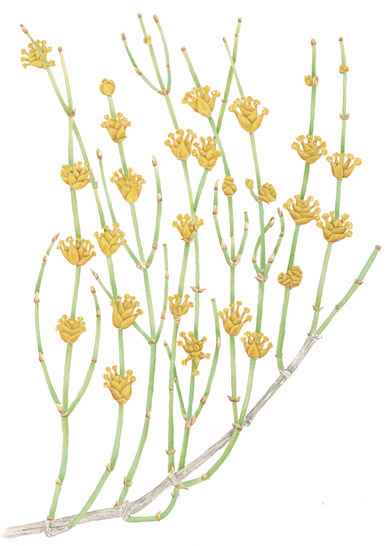
Most plants photosynthesize through their leaves; Mormon tea does not. It has adapted to a desert environment by reducing its leaves to inconspicuous scale-like parts and photosynthesizing through the chlorophyll in its green, jointed stems.
In the spring, when the plants set seed, they appear to be flowering plants; they are not. Mormon tea is a gymnosperm, the group of nonflowering plants that includes pines and junipers. Ephedra species have small male and female cones on separate plants. Males, whose pollen is dispersed by wind, occur on steeper, drier spots, where wind prevails. Females, which require more moisture and nutrients for seed production, occur on wetter sites.
Native people and early pioneers made a medicinal tea from the stems and leaves. Mormon tea contains pseudoephedrine, a drug commonly used in nasal decongestants and closely related to ephedrine. Old World species of Ephedra contain ephedrine.
FOUR-WING SALTBUSH
Atriplex canescens
Amaranth family (Amaranthaceae)
2–3 feet
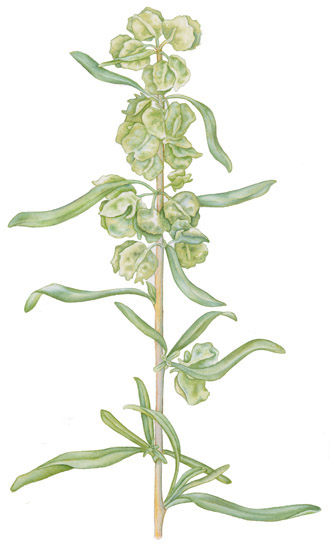
Four-wing saltbush has the widest distribution of any saltbush, growing from South Dakota to Mexico and west to California. It is an important forage plant for a variety of wildlife because the plants are evergreen and lack spines. The common name refers to the four-winged fruit. Four-wing saltbush plants have 1-inch-long linear leaves, in contrast to the more rounded, smaller leaves of the closely related shadscale (A. confertifolia).
One defining characteristic of desert ecosystems is that potential evapotranspiration (the amount of moisture escaping back into the air from plant transpiration and soil evaporation) exceeds annual precipitation. If this difference is large enough, then water does not leach salt to great depths and soils can accumulate salt in the root zone. As the name implies, saltbush can survive on these salty soils, although they generally grow on sandy soils and even sand dunes. Atriplex sp. pump excess salts into hair-bladders on the leaf surface; eventual rupture of these hairs excretes the salt.
Most plants either have both sexes on the same plant (monoecious: Latin for “one home”) or on separate plants (dioecious: Latin for “two homes”). Four-wing saltbush is generally dioecious, but in some situations they may be monoecious or even transsexual and can reverse themselves, switching from male to female and back again.
The Amaranth family recently absorbed the goosefoot family (Chenopodiaceae), other members of which include spinach, beet, and chard.
GREASEWOOD
Sarcobatus vermiculatus
Amaranth family (Amaranthaceae)
3–8 feet
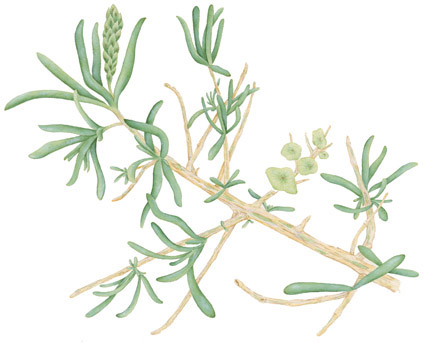
Despite growing in the harsh environment of alkali or saline flats, greasewood has bright green, fleshy leaves and can reach heights of 8 feet. Many native animals forage on the young shoots and use the thorny plant for protection. Some livestock may also eat it, but too much can be toxic. Greasewood survives in soils inhospitable to most plants by having deeply penetrating roots that can reach down to 57 feet to obtain groundwater.
Both male and female floral parts occur on the same plant. To ensure that an individual plant does not self-pollinate, the male stamens mature and dry several weeks before the female pistillate flowers mature. Cross-fertilization leads to greater genetic diversity and thus a greater ability to adapt. (See Plateau Striped Whiptail, page 166, for more information.)
Some people use the term greasewood to refer to creosote bush (Larrea tridentata), a ubiquitous plant of hot deserts. Sarcobatus refers to the plant’s thorny growth: sarkos (fleshy) and batos (thorn). At present there is a debate in the botanical community as to whether plants in the genus Sarcobatus should be in their own family, Sarcobataceae. Only time and science will tell.
RUSSIAN THISTLE
Salsola tragus
Amaranth family (Amaranthaceae)
Up to 3 feet or taller
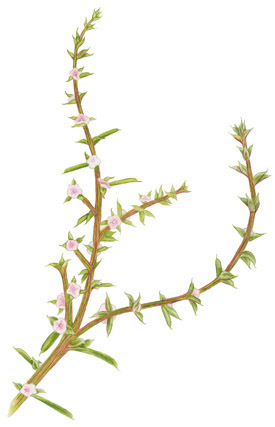
Most people can identify mature Russian thistle, also known as tumbleweed, which looks like the skeleton of a normal shrub and can range in size from a soccer ball to a Volkswagen Beetle. Fewer people recognize the seedling and juvenile plants’ bright green, succulent, grass-like shoots, which are usually red or purple striped. The inconspicuous green flowers grow at axils (where leaves branch off the stem) of the upper leaves, each one accompanied by a pair of spiny bracts. Mice, bighorn sheep, pronghorn, and some people eat the tender shoots.
As the plants roll down a desert road, they disperse upward of 250,000 seeds per plant. They are unusual in that they lack any protective coat or stored food reserves. Instead, each seed is a coiled, embryonic plant wrapped in a thin membrane. To survive winter without a warm coat, the plant does not germinate until warm weather arrives.
When moisture hits and the temperature is between 28°F and 110°F, the seed uncoils and germinates, shooting out two needle-like leaves. By autumn the plant has reached maximum size, flowered, and begun to dry out. A specialized layer of cells in the stem facilitates the easy break between plant and root and the journey begins anew.
Like many alien weeds, tumbleweed exploited the destruction of native ecosystems. When farmers removed prairie grasses, they created a perfect environment, smooth and flat, for a plant that could roll across the landscape dispersing seeds. Herbicides now control the spread of Russian thistle by disrupting the maturation process of the plant.
Native to the arid steppes of the Ural Mountains in Russia, tumbleweeds were first reported in the United States around 1877 in Bon Homme County, South Dakota, apparently transported in flaxseed imported by Ukrainian farmers. Within two decades it had tumbled into a dozen states and by 1900 had reached the Pacific Coast.
SHADSCALE
Atriplex confertifolia
Amaranth family (Amaranthaceae)
1–3 feet
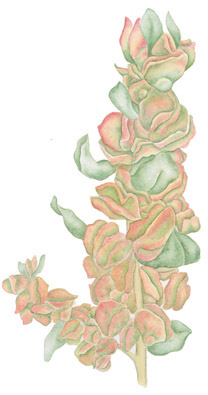
Shadscale grows on hard, stony alkaline soils throughout the arid West. It is often the dominant plant in such environments. Ranchers regard it as important winter browse for domestic grazers. Shadscale’s low growth, usually less than 3 feet tall, and edible fruits and leaves make the plant an important food source for small rodents and jackrabbits. The small rounded leaves are gray and often tinged with red. Unlike the closely related four-wing saltbush, shadscale has two-winged seeds. Spiny saltbush, another common name, refers to the pointed branches that protect the plant from herbivores.
BROOM SNAKEWEED
Gutierrezia sarothrae
Sunflower family (Asteraceae)
Up to 3 feet
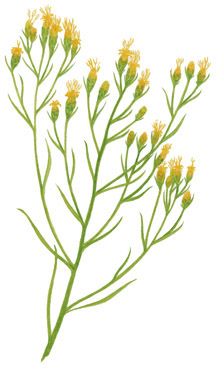
Like rabbitbrush, snakeweed produces yellow flowers in the fall and commonly occurs along roadsides and overgrazed or disturbed soils. These two plants are often mistaken for each other, though snakeweed is generally half the size of rabbitbrush, has slender stems, and flowers with both rays and disks (see page 46 for discussion of rays and disks). Snakeweed leaves are 1 to 3 inches long and often sticky.
All plants adapt to their environment, and snakeweed is no exception. In areas where spring precipitation predominates (north), snakeweed plants develop a high root density in the topsoil to help them obtain and use the moisture from light rains. By contrast, southern populations develop deeper and thicker roots to obtain water stored from fall and winter precipitation, which allows for survival during drier springs. A corollary to this deep root development is that these southern plants have larger canopies and drop fewer leaves during the summer than their northern counterparts.
The generic name refers to Pedro Gutierrez, a nineteenth-century correspondent for the Botanic Garden in Madrid.
BUSH ENCELIA
Encelia frutescens
Sunflower family (Asteraceae)
1–4 feet
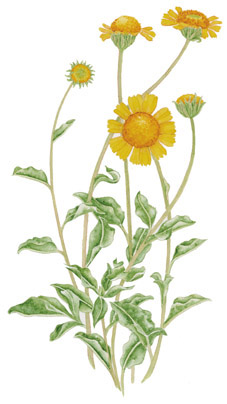
Most shrubby composites bloom in summer or fall; bush encelia is an exception, flowering in late spring instead. The yellow flowers grow at the end of a several-inch-long yellowish stem. Unlike other desert species of Encelia, bush encelia does not have hairy leaves, which increase light reflection, resulting in lower leaf temperatures. The plant instead depends upon higher water loss through its leaves (transpirational cooling) to survive in hotter weather. Although it often grows along roadsides, bush encelia also can be found on talus and slickrock associated with blackbrush and shadscale. The genus name honors Christopher Encel, an English botanist who wrote a book on oak galls in 1577.
RABBITBRUSH
Ericameria nauseosa
Sunflower family (Asteraceae)
1–7 feet
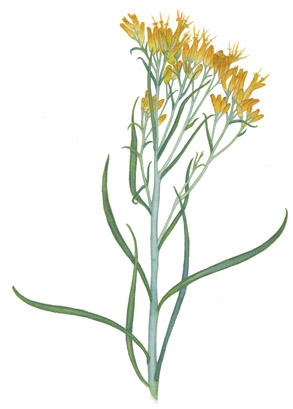
In late summer a yellow border begins to appear along many roads in the arid southwest. Taking advantage of extra roadside runoff, rabbitbrush quickly colonizes this human-made environment, as well as riparian habitats and the piñon-juniper zone. They are the most conspicuous plant in the fall and easily identified by their abundant flowers, 3-inch-long linear leaves, and strong scent.
Rabbitbrush’s color and fragrance also attract numerous insects and spiders. Some come to feed on the abundant nectar while others come to feed on these pollinators. Two common rabbitbrush dwellers are the golden crab spider and the red-and-black longhorn beetle. The spiders do not build webs; instead, they catch their quarry with a quick rush followed by a paralyzing bite. Rabbitbrush was formerly in the genus Chrysothamnus.
Riparian or Protected
The following section is characterized by plants that live along watercourse banks or that live in restricted habitats like protected canyons or alcoves.
POISON IVY
Toxicodendron rydbergii
Cashew family (Anacardiaceae)
Up to 6 to 8 feet
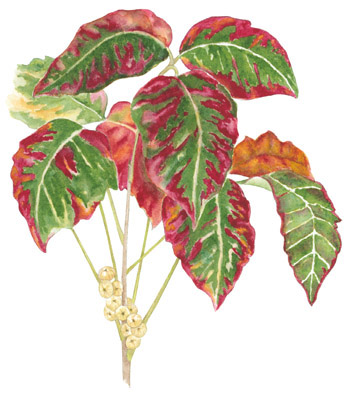
Poison ivy was one of the earliest plants noted by the first colonists of the United States. Captain John Smith is credited with bestowing the common name because he thought it resembled English or Boston ivy. He also observed that the plant “caused itchynge and blisters.”
At least ten species and subspecies, ranging from eastern Asia to Guatemala, bear the common name poison ivy. Our local representative is Toxicodendron rydbergii. The generic epithet comes from the Greek toxikos (poisonous) and dendron (tree). The species name honors Per Axel Rydberg (1860–1930), a Swedish-born botanist who wrote two books on the flora of the Rocky Mountains.
Like the better known eastern species (T. radicans), T. rydbergii has three leaflets growing together, orange to red fall foliage, and small, cream-colored berries. The western variety grows as a small shrub, does not have a viny structure, and is found in protected or moist environments, such as hanging gardens, streamsides, and shady canyons. Plants can reach heights of 6 to 8 feet or more.
More than 2 million people per year have a reaction to poison ivy. Symptoms most often occur between 24 and 48 hours after exposure. The active ingredient, urushiol oil, a word dervied from the Japanese term “urushi” for the Japanese lacquer tree, T. vernicifluum, occurs in the sap, and breaking or crushing the plant is usually necessary to induce infection, although touching the leaves can also trigger a reaction. In sensitive people, as little as 0.001 milligram can cause a reaction.
“Treatment” for poison ivy dermatitis ranges across the spectrum. Some more novel approaches include kerosene, buttermilk, strychnine, and everyone’s favorite medicine, cream and marshmallows.
Washing with soap and water immediately after touching a plant is the recommended first line of therapy, although added moisturizers and oils in typical soap may actually spread the urushiol oil. Tecnu Oak-N-Ivy Brand Outdoor Skin Cleanser, a mixture of organic solvents and wood pulp byproducts, does effectively wash off urushiol. It was originally developed in 1961 to remove radioactive fallout dust.
NETLEAF HACKBERRY
Celtis reticulata
Hemp family (Cannabaceae)
15–20 feet
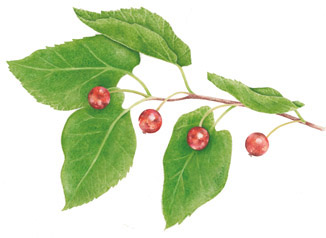
Netleaf hackberry ranges from riparian woodlands to rocky uplands but grows best in sheltered areas, such as washes, rocky out-crops, and narrow canyons. In these micro-habitats this small tree exploits the surface and subsurface water—especially the water that accumulates in rock cracks. They seldom form large groves, usually occurring as small or highly localized thickets.
Netleaf hackberry receives its common name and specific epithet from the netlike veins found on the leaves. The toothed, asymmetrical leaves feel like crunchy, fine-grained sandpaper. A wide variety of animals use hackberry trees for cover and nesting sites. Birds and mammals eat the reddish, fleshy fruit.
RUSSIAN OLIVE
Elaeagnus angustifolia
Oleaster family (Elaeagnaceae)
Up to 40 feet
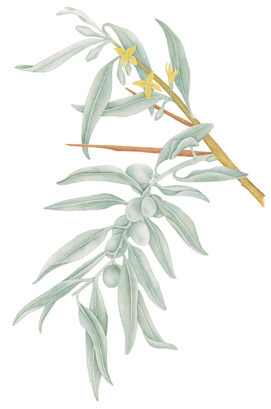
Russian olive, an alien species, germinates in a wide range of soil types over a wide range of seasons. The trees normally become established in or near a cottonwood stand. Over time the shade-tolerant Russian olives can supplant the native cottonwoods and willows, creating dense thickets of thorny trees that can exclude wildlife. Fewer insects are also found in the thickets, which means fewer insectivorous birds. In addition, many cavity-nesting animals lose potential sites when Russian olives grow instead of cottonwoods.
These 20- to 40-foot-tall trees, which take up to 10 years to mature to seed production, are easily recognizable by their thorns and lance-shaped gray-green leaves. Yellow flowers appear in spring, producing a strong odor relished by few. In contrast to the tree’s negative effects, the sweet fruit provides a food source for birds throughout the winter.
Russian olive was introduced into this country as early as the 1850s as a windbreak and for erosion control. It escaped cultivation in Utah around 1924 and is now considered to be a noxious weed in some counties.
DESERT OLIVE
Forestiera pubescens
Olive family (Oleaceae)
6 feet or taller
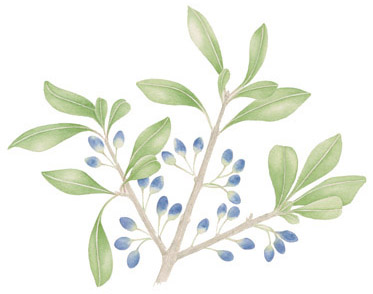
Coyote bush, New Mexican forestiera, or desert olive, as it is also known, grows along riparian corridors, often forming dense thickets. In spring, the large shrub produces yellow flowers that lack petals. Unisexual and bisexual flowers are on the same plant. Two to four stamens give the flower its yellow color. Simple, opposite leaves appear after flowering. In summer and fall, birds visit the plant seeking the tart, blue-black fruit. When foxes and coyotes eat the berries, they produce purple-stained, seed-filled fecal matter, often found far from its riparian source.
The generic name refers to Charles Le Forestier, an early nineteenth-century French physician and naturalist.
DOUGLAS FIR
Pseudotsuga menziesii
Pine family (Pineaceae)
Up to 130 feet
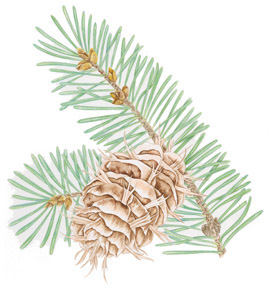
Douglas fir grows in a few scattered alcoves and other protected sites throughout the region. Although only a handful exist, they provide important insight into the last ice age. From evidence gathered in pack rat middens, ecologists propose that Douglas fir and limber pine (Pinus flexilis) were the dominant trees in canyon country between 20,000 and 12,000 years ago.
Two types of relict communities occur in canyon country: vestigial remnants of formerly widespread flora or fauna that have persisted through the warming and drying of the intermountain region, or areas that have not been affected by human activities, particularly livestock grazing. By definition most of these are small-scale ecosystems. Isolated buttes and mesas contain grasses and biological soil crusts that have never been grazed. Douglas fir and aspen that grow at low elevations are forest islands in a desert sea.
The available clues point to continuous habitation over the last 20,000 years. The limited data from pack rat middens shows Douglas fir growing abundantly near present-day locations as recently as 6,000 years ago. The modern trees mostly grow in well-protected, north-facing sites that have a source of water—an environment that resembles ice age climates. Look for their cones with their characteristic three-pronged bracts.
BIRCHLEAF BUCKTHORN
Frangula obovata
Buckthorn family (Rhamnaceae)
Up to 15 feet
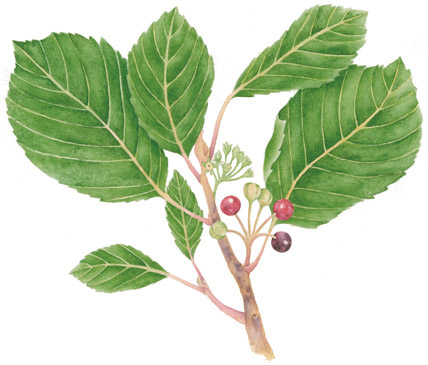
Birchleaf buckthorn generally occurs in the mountainous areas of the northern Sonoran and Chihuahuan Deserts but creeps up along the Colorado River into southeast Utah. It grows along riparian areas, and favorable microhabitats including overhangs and cracks in rocks. Buckthorn has 3- to 4-inch-long, dark green leaves with deep veins and finely toothed margins. The older bark is smooth and gray, whereas young twigs are greenish to reddish. Many birds eat the green to purple-black berries.
FRÉMONT’S COTTONWOOD
Populus fremontii
Willow family (Salicaceae)
Up to 90 feet
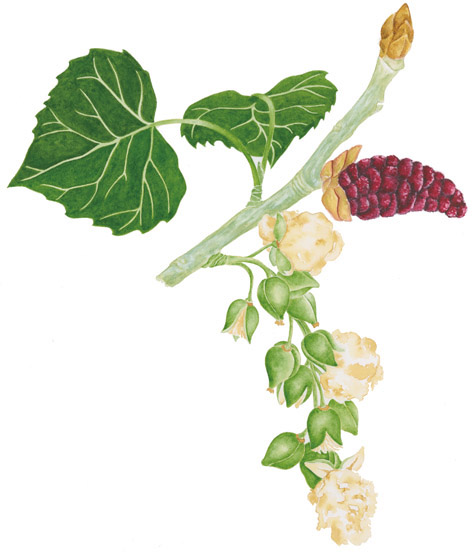
Cottonwoods once formed extensive stands on riparian corridors throughout the Southwest, lending their Spanish name, alamo, to many places. At present, dam building, livestock grazing, extensive clear-cutting, and stream channelization have reduced the original forests by 90 percent. On the other hand, because branch cuttings root easily in moist soil and the trees grow quickly, many new cottonwoods have been planted throughout human-populated areas. Males are the preferred sex to plant because female plants’ seeds release white cotton, which many people dislike.
Cottonwoods affect the entire riparian community. Their deep roots prevent erosion and keep soils porous, allowing water to percolate downward. The large trees provide nesting sites for Great Blue Herons, ravens, and hawks; dam building material for beavers; and holes for owls, raccoons, and other cavity dwellers.
Three species of cottonwood grow throughout the region; Frémont’s cottonwood is the most common. It has large, triangular leaves with rounded teeth. In fall they turn golden yellow. The other two species, narrowleaf cottonwood (P. angustifolia) and lanceleaf cottonwood (P. x acuminata), have narrower leaves and usually occur at higher elevations, generally above 6,500 feet. P. x acuminata is a hybrid of crosses of P. fremontii and P. angustifolia.
According to one cattleman, cottonwoods provided a natural remedy for bad water consumed on the trail. Cowboys would take the bark, boil it, and consume the tea, which is “a hell of a drink, a wonderful astringent, and a bitter dose.”
COYOTE WILLOW
Salix exigua
Willow family (Salicaceae)
6–9 feet
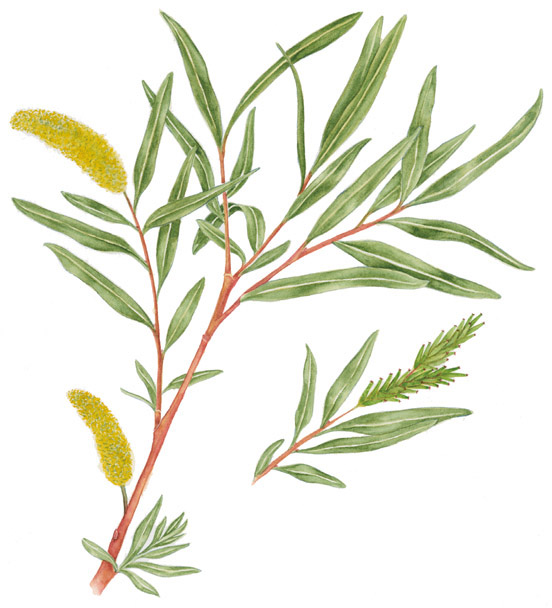
Along with cottonwoods, willows are the dominant native plant in streamside (riparian) environments. Both plants require abundant water near the ground’s surface. Willows, unlike cottonwoods, are insect pollinated, a feature not commonly associated with small-flowered plants. They reproduce by seeds and through root suckering.
Coyote willows have long, narrow, toothed leaves and rarely reach heights of more than 10 feet. Gray hairs cover the top side of the leaves. Apetalous flowers occur in catkins, short spikes of inconspicuous flowers. The plants are dioecious; male catkins are more prominent due to silky hairs. Beaver, deer, and livestock forage on the plants.
Several species of Salix grow in the riparian habitats of the Southwest; they are notoriously hard to tell apart. Another common species, the peachleaf willow (S. amygdaloides), reaches heights of 30 feet. Below 5,000 feet, Goodding’s willow (S. gooddingii) is also common. Leslie Newton Goodding was an American botanist. All species contain salicin in the bark and stems. When eaten, this compound breaks down into salicylic acid, the base ingredient of aspirin.
BOXELDER
Acer negundo
Soapberry family (Sapindaceae)
12–38 feet
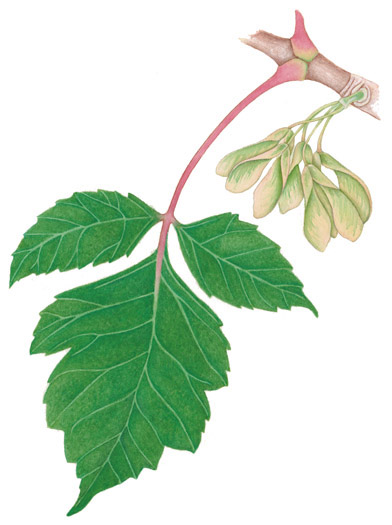
Although boxelders commonly grow along streambanks throughout the Southwest, they may be more familiar to people as an ornamental tree in towns, where people desire their fast growth and yellow fall foliage. The common name came about because people used to box, or tap, the trees for their sap. There is some debate about the origin of Acer, the ancient name for maples. “Ac” means “sharp,” and is used in a variety of plant names, such as Acacia, and more common words, such as acerbic. Some believe that the reference to sharp comes from the pointed leaves, whereas others state that it refers to the use of maple in the heads of pikes and lances.
Similar to many other plant species (see greasewood and four-wing saltbush), male plants dominate in drier, nonstreamside habitats, and females thrive on wetter sites. This distribution has led to distinct growth habits. Males are more efficient at using water on both a long-term and short-term scale but have a lower rate of photosynthesis. Therefore males are more drought resistant but are out-competed in a moist habitat because females grow faster. A further advantage of drier sites for males is that pollen spreads farther and more easily on drier sites than wetter sites.
TAMARISK
Tamarix chinensis
Tamarisk family (Tamaricaceae)
Up to 20 feet
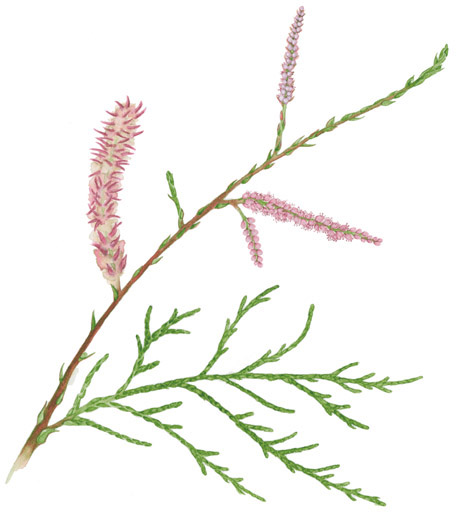
Salt-cedar, or tamarisk as it is more commonly known, was introduced into the United States from the Middle East in the early 1800s for erosion control. Nurseries in California began to sell the plant in 1861, and by 1880 wild tamarisk appeared in Utah. One geographer estimated that tamarisks moved up the rivers at a rate of 12 miles per year. They still are a prevalent stream-side plant, characterized by minute, scaly leaves; fragrant, white to pinkish flowers; and dense, woody growth.
Tamarisks have several adaptations that helped the plants spread so far, so quickly. A single mature plant can produce 500,000 seeds each year, which can germinate within 24 hours of becoming wet. Tamarisks bloom from April through October, and seeds can establish themselves in fall when other species’ seeds are not present. Once they become established, tamarisks have further adaptations to resist invasion by other species. A dense thicket of tamarisk has little bare soil underneath in which other plants can set seeds. In addition, tamarisks excrete salt from leaf openings, which falls to the ground, creating a hypersaline condition that kills grasses and seedlings.
Despite all these adaptations, tamarisk may not be able to maintain its dominance over native willows and cottonwoods. Some researchers now believe that tamarisk has reached its maximum distribution. At this point, though, we have only about 50 years of data on tamarisks, much of it conjectural. Ecologists are just starting to learn about the tamarisk life cycle and its place in the riparian ecosystem. Tamarisk invasion occurred at a time when humans were significantly altering western waterways. Will it continue to thrive in its current state or will native species reestablish themselves? Fifty years is not a long time in the natural world.
A different species of tamarisk, T. aphylla, grows more as a tree, up to 65 feet tall with a 3-foot-diameter trunk. Known as athel, it is not considered to be an invasive species. They are common at Lake Powell.
Close-up
Biological Control of Tamarisk
Ecologists have long known the downside of the pervasive invasion of tamarisk. The plants increase soil salinity, dry up springs, lower water tables, make wildfire more frequent, and outcompete native plants. One study estimated the water costs of tamarisk annually at $133 million to $285 million. Because of these drastic changes, there has been a widespread attempt to control and/or eliminate tamarisk. Attempts have included herbicide, hand cutting and stump removal, and bulldozing and burning, but they have either been too expensive, too labor intensive, or too ineffective.
In the 1980s, ecologist Jack DeLoach begin to investigate the possibility of using native enemies to biologically control tamarisk. His team’s research found that a species of beetle, Diorhabda carinulata, completely defoliated tamarisk in its native habitat. They are part of the leaf beetle family, Chrysomdelidae, other members of which have been used successfully for controlling St. Johns wort and purple loosestrife. After determining that the beetles didn’t feed on any plants native to North America, researchers released beetles in open fields in six states beginning in 1999. The green and black beetles are now found on an estimated 10 million acres of land in southern Utah and western Colorado.
At about 0.25 inch in length, tamarisk beetles are not conspicuous, but they can gather in immense groups, attracted by the plant’s aroma and by the males’ pheromones. Predators include birds, assassin bugs, and ants. A female tamarisk beetle can lay up to 700 eggs during her two-month life. The larvae hatch in a week, eating voraciously until they descend to the ground and pupate into yellow cocoons, which develop into adults about a week later.
Adults, which don’t fly well till the temperature reaches 80°F, start to enter dormancy when the days shorten to 14.5 hours of sunlight. They emerge in spring when tamarisk have begun to sprout new leaves. Depending on latitude and weather, females can lay eggs multiple times in a single year.
Tamarisk beetles generally do not kill tamarisk in a single season. Defoliation prevents plants from photosynthesizing, but they can produce new foliage in the same or following season. With continued defoliation over several years, the plants usually cannot recover and die. Although some have called the defoliated plants ugly, they also represent the success of the biocontrol program. Plus, they still play an ecological role by providing a complex structure that attracts birds, small mammals, and reptiles, all of which will further aid recovery, says Tim Graham, a former USGS ecologist who has been monitoring tamarisk beetles in southeast Utah for many years. He adds that in many locations dense willow stands have colonized riparian habitat in front of the former tamarisk stands.
The changes caused by the beetles are widespread across much of the northern Colorado Plateau. One of the best places to see these effects is around Moab. Anyone traveling in the area can see miles of defoliated and/or dead tamarisk along riparian areas. Despite the ongoing success of beetles in controlling tamarisk, Graham says that it needs to be supplemented by additional action. “Perhaps if we put the same time, energy, and money into active restoration that went into attempts at control of tamarisk with poison, chainsaws and bulldozers, we could move riparian systems closer to their pre-dam and pre-overgrazed conditions.”
The introduction of tamarisk beetles is an ongoing experiment writ large across a vast swath of landscape and responses will vary under the different conditions across the west. We have just a few years of data for what will be a long-term process of change.
Mixed Desert Scrub
The following plants are characterized by existing in sandy and rocky soils. This covers a wide range of plants that may also inhabit the piñon-juniper woodland.
WINTERFAT
Krascheninnikovia lanata
Amaranth family (Amaranthaceae)
Mostly 3 feet or taller
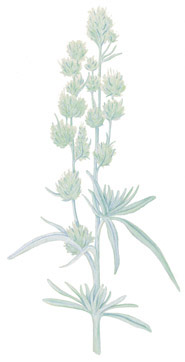
The common name alludes to the plant’s importance as a winter browse for wildlife and livestock. Heavy overgrazing, though, has drastically reduced the small shrub’s abundance throughout its range. Winterfat can form relatively pure stands but is more often associated with sagebrush, rabbitbrush, piñon pine, and junipers. Like many desert shrubs, winterfat depends upon an extensive fibrous root system and a taproot that can penetrate as deep as 25 feet to survive drought conditions.
The plants produce inconspicuous flowers in the summer. Cottony hairs, which cover the ripened fruits and soften the look of the pointy branches, aid in wind pollination. The scientific name honors eighteenth-century Russian traveler and naturalist Stepan Krascheninnikov, who made extensive studies in Siberia.
SKUNKBUSH
Rhus trilobata
Cashew family (Anacardiaceae)
2–8 feet
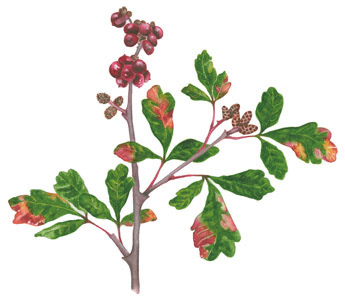
Like other members of the cashew family, which includes poison ivy, pistachio nuts, and mangos, skunkbush leaves turn rusty red in autumn. These large shrubs are easy to identify by their trilobed leaves, which when crushed emit a distinct odor (hence skunkbush) disliked by many people. Unlike poison ivy, the leaves do not produce allergic reactions. Another name, lemonbush, refers to the flavor of the red, sticky berries. Many desert travelers add the corn-kernel-size, vitamin C–rich fruit to their water bottles.
Despite its normally gnarled and crooked growth habit, many people used, and still use, the branches for arrows and baskets. Cutting back or burning the plant stimulates the growth of straight, supple shoots.
SAND SAGEBRUSH
Artemisia filifolia
Sunflower family (Asteraceae)
Up to 5 feet
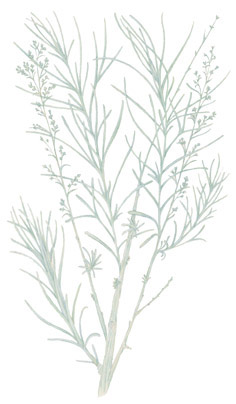
The common name, sand sagebrush, refers to this shrub’s propensity to grow in sandy soils. Another common name, old man sage, alludes to the grayish hairlike leaves. Although not common, these medium-size plants can form large stands in sandy areas.
A debate exists about whom the generic epithet commemorates. Some claim Queen Artemisia, the wife of Mausoleus, who supposedly discovered the medicinal qualities of the genus. Others prefer Artemis, the Greek goddess of the moon and hunt.
LONG-FLOWER SNOWBERRY
Symphoricarpos longiflorus
Honeysuckle family (Caprifoliaceae)
Up to 3 feet
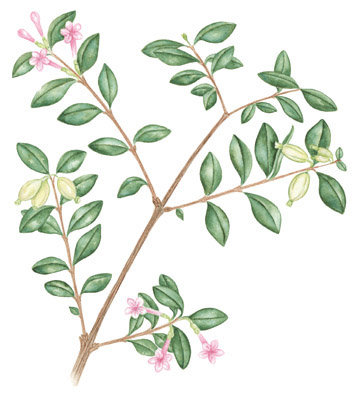
Snowberry plants produce a creamy white berry in autumn. Many birds and small mammals consume the pea-size berries. The 1- to 3-foot-tall shrubs grow on dry, rocky slopes throughout the entire region. Like the closely related Utah honeysuckle (Lonicera utahensis), the ½-inch-long tubular flowers grow in groups of two. The honeysuckle’s fruit is black or red.
Another species of snowberry also grows across the region. Mountain snow-berry (S. oreophilus) generally grows at higher elevations, although it may creep down into sagebrush regions. It also has white fruit. Both species are deciduous.
FENDLERBUSH
Fendlera rupicola
Hydrangea family (Hydrangeaceae)
3–6 feet
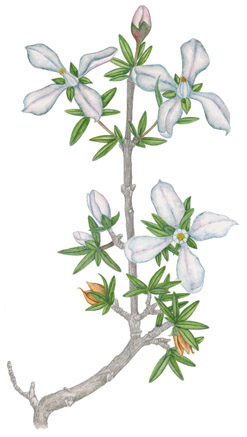
Fendlerbush is an inconspicuous shrub until it blooms in April and May when it produces showy, white four-petaled flowers. Deer and bighorn sheep browse on the narrow, 1-inch-long leaves. The plants grow on rocky slopes, preferring cracks and crevices. When the roots push down into cracks, they begin a process known as biological weathering, where plants and/or animals contribute to the chemical and mechanical breakdown of rocks.
Formerly a member of the saxifrage family, fendlerbush honors August Fendler (1813–1883), a German-born naturalist who was one of the first botanists to collect plants in New Mexico and Texas.
FROSTED MINT
Poliomintha incana
Mint family (Laminaceae)
1–4 feet
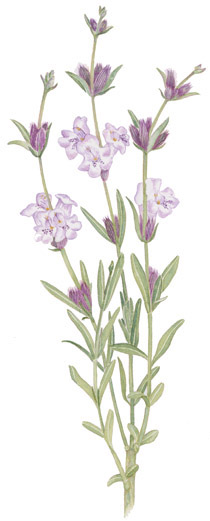
This fragrant shrub is also known as purple sage. Crushing its hirsute leaves releases the aromatic oils, a characteristic of the mint family. The frosted appellation refers to the hairy flowers.
Frosted mint also displays two other aspects of the mint family. It has square stems with opposite leaves, and the flowers are bilaterally symmetrical. Looking straight into a mint flower reveals an almost mouth-like shape with the lower three petals fused to form a lower lip, the stamens protruding like teeth, and the top two petals united into a stiff upper lip. Purple dots on the lower lip act as guides for pollinators seeking the nectar within.
SINGLELEAF ASH
Fraxinus anomala
Olive family (Oleaceae)
4–13 feet
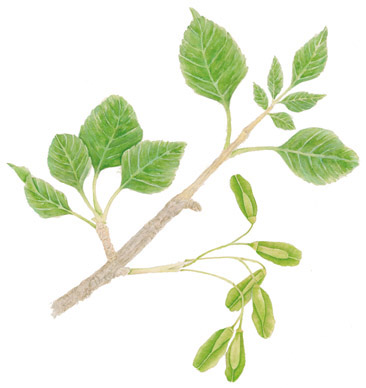
Unlike other ashes, singleleaf ash trees only have one leaf per stem. This adaptation is helpful in an environment of high temperatures and little rain. Fewer leaves mean less surface area available for water loss through transpiration. They also have thicker leaves to prevent drying.
Small, bright green shoots begin to sprout soon after the snow disappears. They eventually develop into 1- to 1½-inch-long leaves. The inconspicuous flowers appear soon after the leaves develop and turn into winged fruit in late spring. Despite the summer heat, the leaves remain until they turn a brilliant yellow-gold in fall. This ash grows in piñon-juniper woodlands, black-brush flats, and mixed desert scrublands. Fraxinus originates from the Greek word phraxis, which means “parting” or “splitting,” most likely in reference to ease of splitting the ash wood.
CORYMBED BUCKWHEAT
Eriogonum corymbosum
Buckwheat family (Polygonaceae)
Up to 4 feet
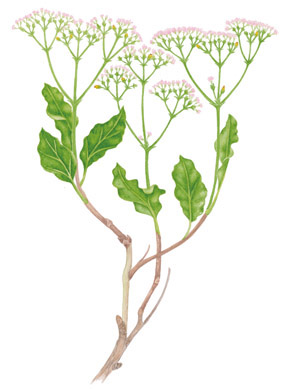
Corymbed buckwheat has a sporadic distribution from southern Wyoming through Utah to Arizona, growing on clayey, sandy, and silty soils. Some varieties produce yellow flowers, but most have white blossoms and all bloom in late summer to fall. Individual flowers are inconspicuous and grow in a terminal umbel that gives the impression of a large flowering head. In good years this buckwheat superficially resembles a giant head of cauliflower.
Corymbed buckwheat, also known as Frémont’s buckwheat, grows in mixed desert scrub or piñon-juniper communities. The Republican Party’s initial presidential candidate, John C. Frémont, was the first known, non-Native to collect a specimen of this buckwheat. He was in Colorado on his third expedition to California in 1845. His pioneering explorations earned Frémont the name “The Pathfinder.”
BLACKBRUSH
Coleogyne ramosissima
Rose family (Rosaceae)
Up to 3 feet
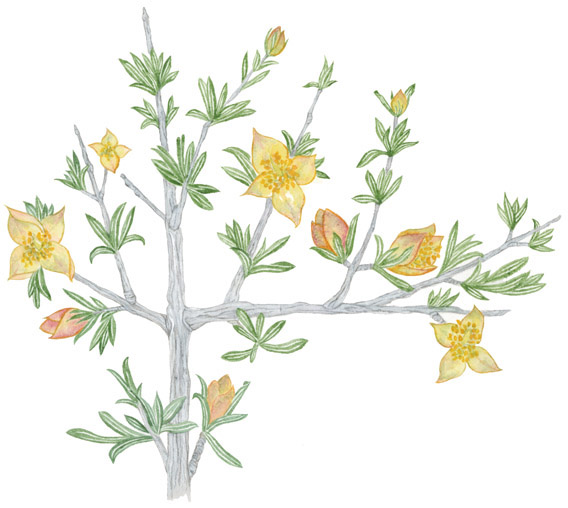
Blackbrush often forms extensive, practically monotypic stands on shallow soils between 3,500 and 6,000 feet along the valleys of the Colorado River and adjacent drainages in southeast Utah. This shrub grows on bench-lands with shallow soils, avoiding bottom-lands where cold air accumulates. Growth and flowering occur in the vernal months, although summer precipitation can produce an additional growth period. To save water, blackbrush drops its older, outermost leaves at the onset of its summer dormancy.
The generally round and spiny plant rarely reaches heights of more than 3 feet. Despite its thorny nature, blackbrush forms a major part of the late fall and winter diet of bighorn sheep, which eat the narrow ½-inch-long leaves. Few other animals consume the plant.
The common name alludes to the shrub’s dark color after rainstorms. Coleogyne refers to the sheath (koleos) that surrounds the ovary (gyne). Ramosissima comes from the Greek for “many branched.” Blackbrush has opposite branches, unlike the alternate branches of the similar-looking curlleaf mountain mahogany (Cercocarpus ledifolius).
Piñon-Juniper Woodland
The most widespread community. Characterized by plants that grow in rocky soils or straight out of the bedrock in joints and fissures.
BIG SAGEBRUSH
Artemisia tridentata
Sunflower family (Asteraceae)
4–7 feet
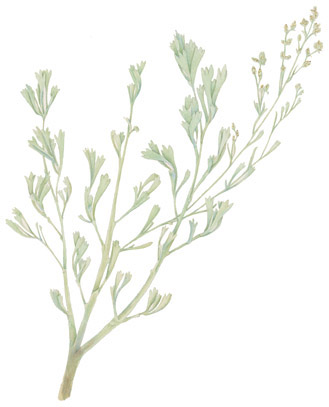
To many people sagebrush evokes the arid West, scenting the air with its pungent aroma. It grows from Nebraska to California and from New Mexico to Montana, the widest distribution of any North American shrub. The aromatic plant now covers about half its historic acreage.
Sagebrush is a crucial member of the steppe lands of the arid West. In this community of short-statured plants, sagebrush functions as the overstory. It provides a protected microhabitat for seedling establishment and for many small animals ranging from Sagebrush Sheepmoths (black and white, 2¾- to 3⅝-inch-wide wings with yellowish body, whose caterpillars feed only on sagebrush: Hemileuca hera) to Greater Sage Grouse (Centrocercus urophasianus). Sagebrush destruction has helped push many of the animals that depend on it into a downward population trend. Some may be proposed for inclusion on the federal list of Endangered and Threatened Wildlife.
FRÉMONT’S MAHONIA
Mahonia fremontii
Barberry family (Berberidaceae)
4–10 feet
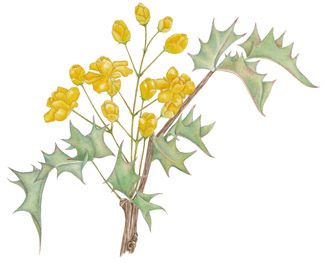
Frémont’s mahonia flowers produce a scent of intoxicating proportions. The yellow flowers have a confusing structure, with different parts variously interpreted as petal-like sepals and petal-like stamens. Furthermore, the pattern is based on a series of whorls consisting of three floral parts, which is unusual for a dicotyledonous plant (dicot). Edible, tangy berries appear after the spring flowering ends. Like other members of the barberry family, the leaves are spine-tipped.
Mahonia seeds can germinate over a wide range of temperatures, including temperatures below those that are tolerated by many other shrubs. This allows the plant’s seeds to germinate in late winter and early spring, when soil moisture is highest. It gives Frémont’s mahonia seedlings an advantage over other plants that germinate in mid- to late spring.
Bernard M’Mahon was an American horticulturist. Thomas Jefferson gave a large proportion of seeds from Lewis and Clark’s expedition to M’Mahon, which he sold as novelties. Many plants in the West bear John C. Frémont’s name, an indication of his widespread exploration and collecting in the 1840s.
Close-up
Galls
One of the best ways to survive in the desert is to remain out of the sun, surrounded by a protective cover. This works quite well especially if someone else goes to the effort of creating your home and providing your food, which is essentially what happens in insect plant galls. Galls are tumerous growths on stems, flowers, fruits, and leaves. They result from an insect injecting eggs into the plant. Galls can be fuzzy and white, scaled like a mini artichoke, shaped like peppercorns, round like a ping-pong ball, flattened like a pancake, or even more bizarre shapes. Each one is or was home to an insect larvae.
Most gall-forming insects are midges (Family Cecidomyiidae), fruit flies (Family Tephritidae), and wasps (Family Cynipae [more than 800 species]), generally less than ¼ inch long, each of which exploits a specific plant species or even subspecies. Galls start to grow after a female deposits an egg. Upon hatching, the larvae begins to feed on its host, which reacts to the invader by altering its growth pattern to try to isolate and wall off the insect. Researchers believe that saliva secreted by the larvae triggers the plants’ defensive reactions and growth of the gall. Larvae often overwinter on the plant before pupating into an adult and chewing an exit hole out of the gall.
Galls generally do not cause significant damage to a plant. Some are valuable to humans, including certain oak galls, often called oak apples, which historically were used to manufacture ink. Native peoples have used rabbitbrush galls for toothaches and stomach problems and smoked creosote galls. Still other galls and their larvae may serve as home or food to even smaller insects, as well as birds.
In canyon country, rabbitbrush, big sagebrush, oaks, saltbush, and junipers often feature a variety of galls. At least twenty-one insect species form galls on rabbitbrush, including twelve fruit flies and nine midges, which also attack sagebrush.
Sample Galls
Wooly stem gall midge (Asphondylia floccosa)—Produce large, white, cottony galls on shadscale.
Sagebrush gall midge (Rhopalomyia pomum)—Reddish, smooth, globular galls on bigleaf sage.
Juniper gall midge (Walshomyia sp.)—Pineapple cone-like, with green bracts below and silvery gray in the center on junipers.
Oak gall wasp (Andricus sp.)—Round galls may be smooth, rough, singular, clustered, tan, red, or spotted depending on which cynipid wasp is responsible.
UTAH JUNIPER
Juniperus osteosperma
Cypress family (Cupressaceae)
Up to 35 feet
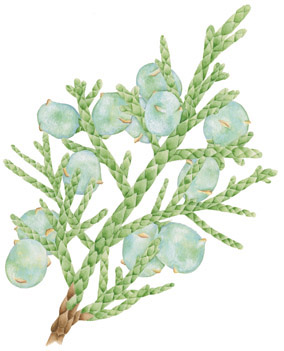
Two species of juniper, Utah and one-seed (J. monosperma), grow throughout the 4,500- to 7,000-foot range. They are not easy to tell apart, but one-seed berries usually are smaller (pea versus gumball) and the plants are shrubbier with multiple branches growing from the base. The light blue berries are not true berries but modified cones wrapped in a drought-resistant waxy coating. Berries from the common juniper (J. communis), which grows throughout the Western Hemisphere and at higher elevations in canyon country, are used for flavoring gin.
The tree’s most characteristic feature—gnarled, dead-looking limbs—reveals one of juniper’s adaptations to arid living. In times of drought, the plant can shut off water to some of its branches. Those limbs will eventually die, but the rest of the plant will continue to grow and produce seeds. The Utah juniper and piñon pine make up the most prevalent plant community, the piñon-juniper woodland, across the Southwest.
OAK
Quercus species
Beech family (Fagaceae)
Up to 30 feet
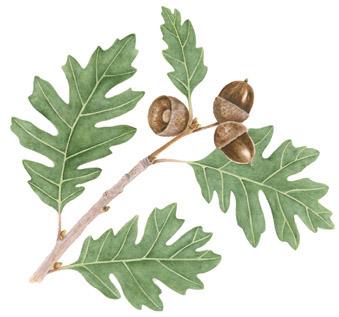
Oaks are a notoriously promiscuous group of plants with numerous species interbreeding. This creates a conundrum for botanists attempting to ascertain which species is which. In the field, location often provides the best indicator. Three species occur in Utah. Shinnery oak (Q. havardii) generally grows in sand dune areas, where it stabilizes wind-blown soil. Gambel’s oak (Q. gambelii), the most widespread species in the Southwest, is found in higher and cooler spots, forming a belt in the Colorado Plateau laccolithic mountains between 6,500 and 9,500 feet. Both species are deciduous and reproduce clonally. The one evergreen species, shrub live-oak (Q. turbinella), mostly occurs south of this area.
Oak’s edible seeds and leaves act as a magnet attracting many animals. Deer, porcupines, and caterpillars forage on the leaves. Woodpeckers, Scrub Jays, and chipmunks store the fatty acorns for winter use. Many other birds come for the abundant insect populations.
Quercus is a Latin term for “beautiful tree.” Valery Havard traveled in Texas as a botanist with the US Army in the late 1800s. See Long-nosed Leopard Lizard (pg. 161) for information on William Gambel.
PIÑON PINE
Pinus edulis
Pine family (Pinaceae)
Up to 35 feet
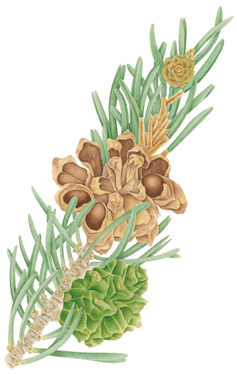
Along with junipers, piñon pine forms the dominant ecosystem across much of the Colorado Plateau at elevations between 5,000 and 7,500 feet. This community is known as the p-j woodland or pygmy forest. Piñons, which are more drought intolerant, generally grow in the higher portion of the zone. Both species rarely exceed 20 feet in height and may take 150 years to reach that point. Piñons are easy to recognize by their rounded crown and irregular shape. The short needles occur in clusters of two.
The specific epithet, edulis, refers to the edible nuts, which contain over 3,000 calories per pound. Trees do not produce cones each year; a bumper crop occurs only every 3 to 7 years. Like many other conifers, piñon pines have “mast” years of high seed production followed by years of minimal seed output. Masting is a defense against predation; most seeds are not eaten during masting, although many may be cached.
Because masting does not occur regularly, animals cannot adapt and plan to have larger broods to take advantage of the extra food. Or, if they are rapid reproducers, their population will crash in the years following a mast, when food resources are slim.
UTAH SERVICEBERRY
Amelanchier utahensis
Rose family (Rosaceae)
6–15 feet
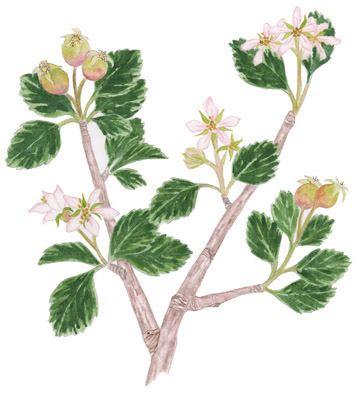
Utah serviceberry is another inconspicuous shrub until spring when its white, fivepetaled flowers open. A sweet-smelling fragrance helps attract numerous pollinators. The upper surfaces of the toothed leaves are hairy and have prominent veins. The leaves emerge after the flowers.
The purple berries ripen in fall. Lewis and Clark, along with many who later crossed America, mixed the ground fruit of this species, or one of its relatives, with buffalo meat and fat to make pemmican. Meriwether Lewis supposedly mistook serviceberry for mountain ash. His corruption of the generic name of the ash, Sorbus, led to a common pronunciation “sarvisberry.”
MOUNTAIN MAHOGANY
Cercocarpus species
Rose family (Rosaceae)
1½–7 feet
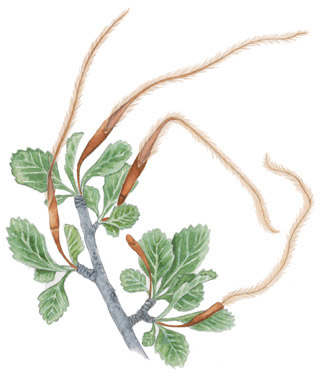
Alderleaf Mountain Mahogany
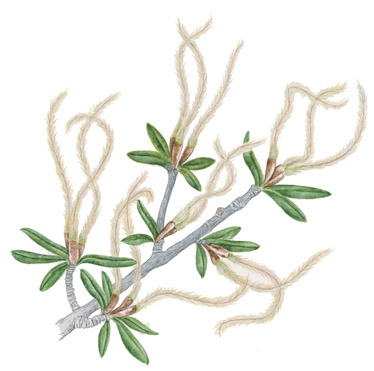
Littleleaf Mountain Mahogany
Three species of mountain mahogany grow in southern Utah. Alderleaf mountain mahogany (C. montanus) has wedge-shaped, deciduous leaves that are toothed at the end and sparingly gray silky above. Curlleaf mountain mahogany (C. ledifolius) resembles littleleaf mountain mahogany (C. intricatus) but has longer (greater than ½ inch) leaves and is much larger overall. Both species are good winter browse for deer and elk.
Littleleaf mountain mahogany usually occurs in isolated patches on warm, dry rocky ridges or slopes. It grows amongst piñon and juniper and is often mistaken for blackbrush. Both plants have short (less than ½ inch), dark green, slightly curled leaves, but mountain mahogany leaves are shinier, its branches are alternate instead of opposite, and it can be a much larger plant.
Like the tropical mahoganies (Swietenia sp.), southwestern mountain mahoganies have extremely hard wood.
CLIFFROSE
Purshia stansburiana
Rose family (Rosaceae)
1½–8 feet
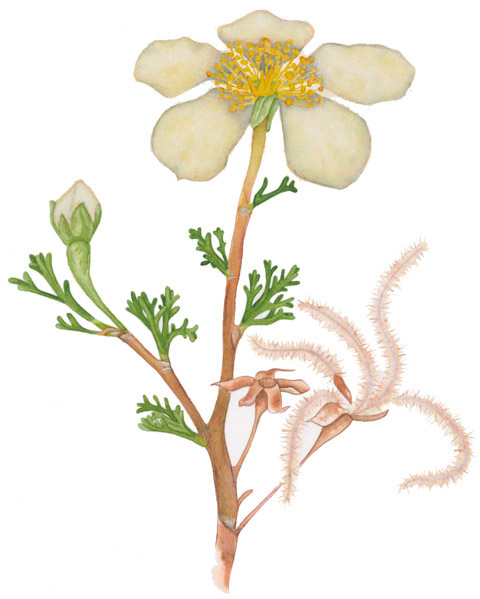
During the vernal months cliffrose is one of the noisiest plants in canyon country; its strikingly aromatic flowers attract numerous bees. One can even detect the odor while driving by in a car. Flowering begins in April with branches closest to the ground blossoming first. A secondary blooming season may occur after spring or summer thunderstorms. Each cream-colored flower is ½ to ¾ inch wide and produces five to ten plumed seeds.
Cliffrose may be confused with Apache plume (Fallugia paradoxa), which generally has a more southerly distribution but does grow in the area. Cliffrose has smaller flowers, fewer plumes, and dotted leaves. (Fallugia honors seventeenth-century Italian botanist Abbot V. Fallugi.)
The world of botanical nomenclature can tax even the mellowest botanist. Consider the naming of cliffrose. Variations include Cowania mexicana var. stansburiana, Cowania stansburiana, and Purshia mexicana. The type specimen came from Captain Howard Stansbury’s Great Salt Lake Expedition. (See Side-Blotched Lizard, page 163, for more information on Stansbury.) Frederick Pursh (1774–1820) was a German-trained botanist who produced the first plant book to cover America north of Mexico, Flora Americae Septentrionalis.